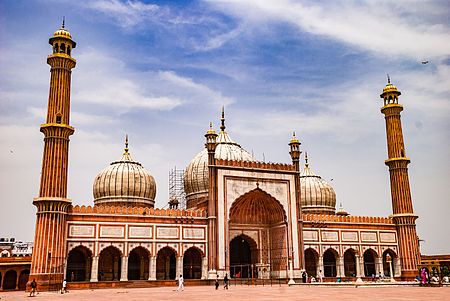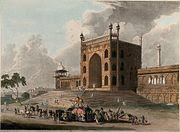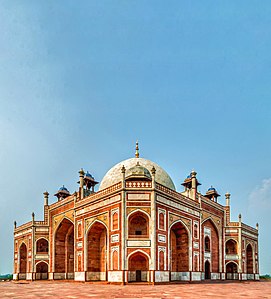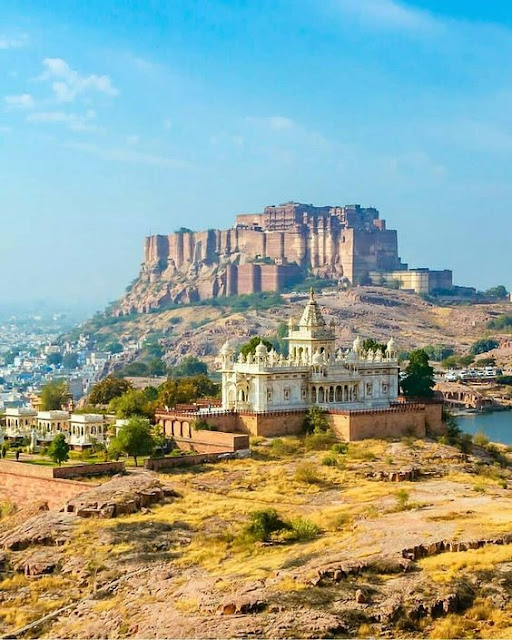Jama Masjid Old Delhi - Instant Information about Jama Masjid, Know the facts, attraction
Jama Masjid, Delhi
The Masjid e Jahan Numa, commonly known as the Jama Masjid of Delhi, is one of the largest mosques in India.
It was built by the Mughal Emperor Shah Jahan between 1650 and 1656 for one million rupees and was inaugurated by Imam Syed Abdul Ghafoor Shah Bukhari from Bukhara, present-day Uzbekistan. The mosque was completed in 1656 AD with three great gates and two 40 meters high minarets constructed with strips of red sandstone and white marble. The courtyard can accommodate more than 25,000 people. There are three domes on the terrace which are surrounded by the two minarets. On the floor, a total of 899 black borders are marked for worshippers. The architectural plan of Badshahi Masjid, built by Shah Jahan's son Aurangzeb at Lahore, Pakistan, is similar to the Jama Masjid.
History
Mughal Emperor Shah Jahan built the Jama Masjid between 1650 and 1656. It was constructed by more than 5000 workers. It was originally called Masjid e Jahan Numa, meaning 'mosque commanding view of the world'. The construction was done under the supervision of Saadullah Khan, wazir (or prime minister) during Shah Jahan's reign. The cost of the construction at the time was one million Rupees. Shah Jahan also built the Taj Mahal, at Agra and the Red Fort in New Delhi, which stands opposite the Jama Masjid.
The Jama Masjid was completed in 1656 AD (1066 AH). The mosque was inaugurated by Imam Syed Abdul Ghafoor Shah Bukhari, from Bukhara, Uzbekistan, on 23 July 1656, on the invitation from Shah Jahan. About 25,000 people can pray in the courtyard at a time. The mosque is commonly called "Jama" which means Friday.
After the British victory in the Revolt of 1857, they confiscated the mosque and stationed their soldiers there. They also wanted to destroy the mosque as an act of punishment for the city. But due to opposition faced, the demolition was not done.
The iconic mosque is one of the last monuments built under Mughal Emperor Shah Jahan. After the construction of the monument in 1656, it remained the royal mosque of the emperors until the end of the Mughal period.
During 1948, the last Nizam of Hyderabad, Asaf Jah VII was asked for a donation of? 75,000 to repair one-fourth of the mosque floor. The Nizam instead sanctioned? 3 lakh, stating that the remaining three-fourths of the mosque should not look old.
Main Facade
In 2006, it was reported that the mosque was in urgent need of repair and then the Saudi Arabian king, Abdullah, offered to pay for it. The Imam said that he had received the offer directly from the Saudi authorities, but requested them to approach the Indian government. However, the Delhi High Court said that this matter had no "legal sanctity" giving no "special equities" to the Imam.
On the 14th of April in 2006, two explosions came soon after Friday prayers and occurred in swift succession. However, it was unclear, how the blasts occurred. Among the casualties, one was in serious condition, whereas the other eight people sustained minor injuries. The then imam, Bukhari commented "here is anger among our people but I am appealing to them to maintain calm".
Jama Masjid Eid Panorama
On the 15th of September in 2010, two Taiwanese tourists were injured after gunmen on a motorcycle opened fire on a bus parked near gate number three of the mosque. After the attack, the police detained 30 people to question and the area was turned into a fortress because policemen were heavily deployed.
In November 2011, the Delhi Police arrested six members of the Indian Mujahideen who were believed to be behind the Jama Masjid blast along with the Pune German bakery blast. Sources said that the "'main man' Imran" allegedly planted the bomb in a car outside the mosque. In September 2013 it was reported that Yasin Bhatkal, a leader of the group, along with Assadullah Akhtar, was arrested the month before and they admitted that they attacked with the on-the-run Pakistani national Waqas. Yasin said that he was ordered by Karachi-based IM head Riyaz Bhatkal to do the task as the Imam allowed "semi-naked" foreigners inside it.
Architecture
The mosque and Red Fort were planned to be a larger planned city named Shahjahanabad. The mosque is considered as the best among all mosques built during the Mughal Empire as it has the best mixture of marble and limestone. The mosque has three great gates, four towers and two 40-meter tall minarets constructed of strips of red sandstone and smooth white marble. The northern gate has 39 steps and the southern side has 33 steps. The eastern gate was the royal entrance and has 35 steps. Out of all these gateways, the eastern one, which was used by the emperors, remains closed during weekdays. The mosque is built on a red sandstone porch, which is about 30 feet (9.1 m) from ground level and spreads over 1200 square meters.
The dome is flanked by two lofty minarets which are 130 feet (40 m) high and consists of 130 steps, longitudinally striped with marble and red sandstone. The minarets consist of five stories, each with a protruding balcony. The adjoining edifices are filled with calligraphy. The first three stories of the minarets are made of red sandstone, the fourth of marble and the fifth of sandstone.
The courtyard can accommodate 25,000 worshippers and occupies 408 square feet. The mosque is about 261 feet (80 m) long and 90 feet (27 m) wide. The prayer hall measures 61 meters in length and 27.5 meters in breadth. It is made up of high cusped arches and marble domes. The cabinet located in the north gate has a collection of relics of Muhammad – the Quran written on deerskin, a red beard-hair of the prophet, his sandals and his footprints embedded in a marble block.
The floor plan of the mosque is similar to that of the Jama Masjid of Agra. It is covered with white and black ornamented marble to look like a Muslim prayer mat. Beside it, a thin black border measuring 3 feet (0.91 m) long and 1.5 feet (0.46 m) wide is marked for the Muslim worshippers. There are 899 total such boxes. The architecture and plan of Badshahi Masjid, which was built by Shah Jahan's son Aurangzeb in Lahore, is closely related to that of the mosque. Before the Revolt of 1857, there was a madrasa near the southern end of the mosque, which was destroyed during the revolt.






Comments